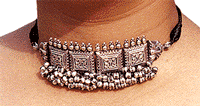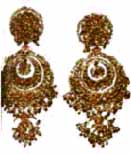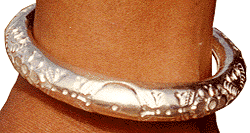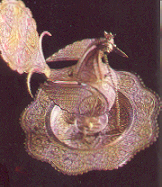Carpets || Woodwork / Carved Crafts (stone, ivory, bones and horns) || Festival Crafts/ Grass Crafts (baskets, mats) || Pottery / Terracotta / Papier Mache || Textiles
JEWELLERY AND METALWARE
 Learn more about Indian Jewelry
Learn more about Indian Jewelry
JEWELLERY
Man's desire to decorate himself
with objects of nature like feathers, seeds, and cowrie shells was the
initial stage in the development of jewellery. The tribals took great
pains to collect these items for their personal decorations.
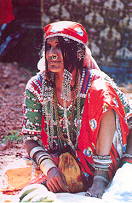 Lambadi woman with
Lambadi woman with
traditional ornaments With the
advent of the agrarian society, jewellery became associated with the status
of a man in society and became a form of savings.
In India, jewellery
is counted as the wealth of a woman and she inherits it from her father
or her husband as gift. Jewellery is mostly associated
with married woman in Indian society and a widow hardly displays any form
of jewellery. A special community of people
called
Sonars in India make the jewels.
They are attached to specific groups and castes
of people. Most of the jewellery items worn by Indian women are the same
but for some regional influences.
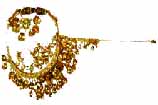 Nose ring
Nose ring Nose
ornaments are widely used throughout India. Different shapes
and designs are involved, as also different materials are used in its
making. Gold, silver, pearls and a variety of precious stones are used.
The nose ornament took shape
only in the 10 the century, with the arrival of the Arab invaders. It
is of different types like the simple Lavang, clove, to Phuli, the elaborately
worked stud, or Nath the nose ring worn in the right nostril and the Bulli
the ring worn in the center just over the lips.
 Tikka, worn
Tikka, worn
on the forehead
Bore is a
head
ornament , which is placed at the parting of the hairs.
It is also called as Boldra in Rajasthan, Gujarat and Madhya Pradesh.
The
tikka
is a round pendant at the end of a long chain and which falls on the forehead.
It is also commonly
used throughout India. Bengal has a range of hair jewels, which decorate
the hair tied as a bun at the back. In South India a variety of ornaments
are available for decorating the loose plait.
A traditional Necklace For the
neck
there are scores of chains, necklaces, and chokers available.
Guluband is made of beads or rectangular pieces of metals strung together
with the help of threads. Then there is the longer Kanthi. Under this can
be worn a silver chain or a
Bead Necklace.
Just like decorative chandeliers, these necklaces hang beautifully and make a statement.
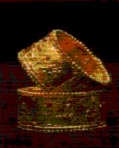 Golden Kadas
Golden Kadas
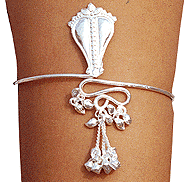 Armlet of silver
Armlet of silver
To adorn
the
hands
there are of course a variety of rings from the cheap silver items to diamond
rings, which are worth a fortune. The top of the hand can be adorned with
the hathpool or Rattan Chowk. For the wrist there are the Karda, the Paunchi,
the Gajira and the Chuda and these all together make up the bracelet category.
Bracelets come in cheap mixed metal varieties to diamond studded gold ones.
Above the elbow women wear the Bazoo, the Joshan and the Bank.
 Belly chains
Belly chains
For the
hips
women wear a series of chain item called the Kandora.
Anklets for
the
toes come in different models of heavy metals and silver.
The delicately worked paizebs ending in tinkling silver hollow bells is
really a good piece to adorn oneself with. The bichua or scorpion ring
for the toe is a symbol for married women.
Designs and the
mode of techniques vary from region to region and the material used depends
upon the status of the wearer in the society. Ornaments range from the simple
metal collections to the silver ones, mixed metals, gold, diamond and platinum.
Regional
Jewellery
The Tribals of
Assam
patronize
silver jewellery but the others use mostly gold items.
The patterns are extremely beautiful and they are finely polished. The
Thuria
earring, which has a most
distinctive design of its own in the form of a lotus with a heavy stem, is a
common item. It is made of gold and studded with rubies. Necklaces and pendants
of other neighboring regions are also common here.
In
West
Bengal, silver and gold jewellery are made. Delicate filigree
works are practiced here.
Tara Kanta
and
Pan Kanta
are some of the finest pieces of jewellery, which are meant for the hair. The
Tara Kantas are pins made in the form of flowers and stars. The Pan Kanta is
a betel leaf ornament, which is fixed at the center of the hair bun.
In
Odisha,
the dominant technique employed is that of granulation and filigree. Both gold
and silver are patronized. Mainly arm jewels, necklaces, nose rings and anklets
are prepared. Finest designs are available for the nose rings.
Maurpankhi, one of the designs
is shaped like a peacock with open feathers and the whole thing is prepared
according to the granulation and filigree technique.
Sampangi
is another nose ring, which is
of the stylized pagoda type from which hangs delicately worked chains each ending
in a small pipal leaf. Another peculiar jewel item of this area is
the
Bank worn on the forearm.
This is formed of stiff chains brought together by adjustable links of flowers.
Sambalpur is famous for brass jewellery. Delicately worked
bangles in different
patterns are available but they need regular polishing.
Punjab
has hair ornaments that are different from the other parts of the country. Here
the Tikka is flat and circular with small pendants hanging in the front of the
Tikka.
In the
Kulu
region, most of the items are made in Hoshiarpur, which has its
own style. The
Pipal Patra made
out of silver pipal leaves fastened to an enameled piece of silver is commonly
worn by the women folk of this area. Here necklaces are formed out of large
metal plates, which are engraved with traditional designs and filled with green
and yellow enamel. The nose ornaments of this area are highly specialized. The
large sized
nath and
boulak designs of
single leaf are specials of this region.
Kashmir
differs a lot from the other regions in jewellery. The most important designs
here are for the ear ornaments. These are known as
Kan Balle or
Jhumka normally worn by the
Muslim women on both the sides of their head. Then comes the common Zululand
, a neck jewel item. Engraving and cut works are the important techniques used
here.
In South India, wearing of silver
jewellery is mostly associated with the tribals and the rest resort to gold
items only. The Chettinad
(in
Tamilnadu) jewellery made of uncut rubies is one of the finest.
The Addigai is an important neck item also made of uncut rubies set in gold.
Mangai Malai, a long necklace made of mango shaped pieces studded with uncut
rubies and diamonds is another specialty of this area. Nowadays diamond jewellery
has caught the fancy of the South Indian women. The Thalli, a necklace, which
is worn during marriage, also has various patterns according to the community
of the couple.
Kerala
has a rich variety of gold designs but precious stones are very rarely used.
Necklaces are available in various shapes and designs. The
Garuda
necklace is famous here.
North India is famous for a special
form of jewellery called
meenakari
combined with the
Kundan technique. Very delicate stuff are developed
using these techniques. First, a basic form of the jewellery is created with
hollow spaces allowed for the stones to be inserted. Then the Meenakar fills
it with lac and engraves delicate designs on it. Lines are engraved to hold
different colors. First the colors, which require the maximum temperature, are
filled in and fired. Then the other colors are applied and fired until both
the sides are enameled properly. Then the Kundan worker places the stones in
their respective area. The piece is then polished with a leather cloth. Different
types of jewel items are prepared by this method and
Jaipur is
the main center specialized in this technique. This art is also practiced in
Delhi, Lucknow and Varanasi.
METALWARE
In India, the mastery over the mining,
smelting and working of metals developed from ancient civilizations. The ancient
Indians used to make weapons of defence from the available metals. Over the
years the availability of metals increased and shaped vessels were developed
gradually for personal kitchen purposes apart from tools and items of armor.
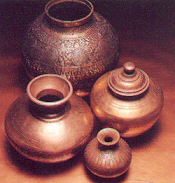 Water pitchers from
Water pitchers from
Maharastra
The commonest objects of metal
in India are the
water
vessels. It is the skill of a
Metal
Smith who makes a water pitcher with a narrow neck and
rounded contours to match the curvaceous form of the women folk! The North
Indian pitchers have a flat base and a top, which rises, at an angle from
the base. The Rajasthani pitcher on the other hand is rounded with a small
mouth and a narrow neck, which prevents any spillage of water in the water-thirst
desert regions.
Another common usage of metal
in India is for the
temple
bells. The bells of India are noted for their depth and
purity of tone and also for their designs and shapes. They are made of
bell metal, which is considered to be the purest of all metals. It is
nowadays also used for making utensils and other ritual vessels.
Indians are not much used to utensils
of glass, porcelain and wood like the Westerners, so most of the items like
cups, saucers, glasses, plates, containers and serving dishes are commonly made
in metals.
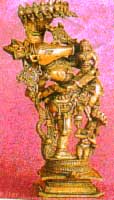 Bronze image
Bronze image
Sheet metal is used
commonly in India for preparing water vessels, serving plates, tabletops,
dowry boxes, etc. Alternatively heating and hammering the sheet metal make
these forms. Another important technique of sheet metal in India is the
deep repousse work.
Here the flat part of the metal is first filled with lac and the basic pattern
is drawn. Then the outline is beaten into the lac with the hammer and the
area to be depressed is beaten down.
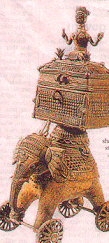 Bronze image
Bronze image
The lac is melted and the right
side is embedded in lac and the process is reversed. The sections that
are to be raised in the final piece are beaten outwards. This process
is repeated until the
deep
repousse work emerges. Finally engraving is done. This
method is used in making vessels and images of worship. Madurai, Tiruchi
and Tanjore in Tamilnadu, Bombay, Varanasi, and Bhuj in Gujarat are specialties
in this technique.
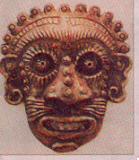 Bronze mask used for
Bronze mask used for
traditional dances In India
Casting
of brass and copper is done in Moradabad. Bell metal casting
is followed in Kerala, West Bengal, Odisha, Biahr and Assam. First the
piece is made in sand or clay and then cast in metal.
Another technique of working
with metals in India is the combining of two metals.
This technique is also called
Ganga -Yamuna.
Combining of different metals is also done by a method called
Damascening
where other metals are encrusted into the basic metal.
The final works are called
Bidar work, Koftagiri, Zarnishan and Tarkashi after the places where they
are prepared.
 Metalwork of Rajasthan
Metalwork of Rajasthan
Koftagiri
is a form of Damascening, an ancient art wherein one metal is encrusted
onto another either in the form of wires or small pieces. Originally gold
and silver were done on iron and steel defense items.
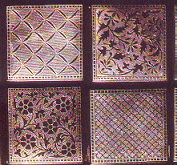 Bidri boxes from Bihar
Bidri boxes from Bihar
Now this is practiced in Kerala
where silver wires are inlaid on iron sheets.
Bidri
is a method developed in Mysore and it involves the damascening of silver
on oxidized black vessels of copper and zinc. It is now practiced in Lucknow
and Purnea and Murshidabad in West Bengal.
In
Zarnishan,
silver pieces are first engraved with the pattern and then inlaid. It
is also called Zarbuland.
Wire patterns are called
Tarkashi.
Tanjore
Plate works, which are very popular throughout India, are
also a form of Damascening. Here copper forms the basic metal over which
silver medallions carrying repousse designs of Gods and Goddesses and
their Vahanas are attached.
Brass decorative rosettes are
also attached.
Enameling
is followed in Jaipur, Delhi, Lucknow and Moradabad, where metal is engraved
so as to provide depressions in which different colored laces are heated and
fixed to create a surface of various colors.
In
Bronze
casting, the
lost
wax method is a fine art in India. Many images of worship are
made by the process. The images are cast according to the rules laid down by
the Shilpa Shastra. In the Lost Wax method, the basic form is first prepared
by melting wax and then it is enclosed in clay moulds and fired. The wax melts
and a clay mould is created with a hollow space. Then hot molten metal is poured
into the mould and then the piece is cooled. The basic solid metal image emerges.
Then finer details are engraved on the surface of the body.
In South India, Madurai, Swamimalai,
Mysore, Bangalore and Karaikal are the important centers practicing this method.
Palitana is an important center for casting of Jain images in Gujarat. Varanasi,
Mathura, Calcutta, Balasore and Puri are also important metal -casting centers.



